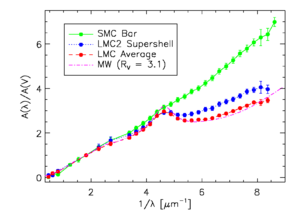انقراض (فلك)
الانقراض Extinction أو التخميد الجوي في علم الفلك هو مصطلح يشير الى خفوت ضوء النجم نتيجة انتشاره في الغلاف الجوي للكرة الأرضية .
مشاهدته
يشاهد الراصد ذلك بشكل واضح عندما يكون النجم السماوي قريبا من الافق وذلك بسبب مرور ضوء النجم في غلاف جوي أكبر. يؤدي الانقراض الى ظهور النجوم السماوية حمراء اللون نتيجة للضوء الاحمر الأقل انتشارا من الضوء الأزرق.
الخصائص العامة
الشكل العام لمنحنى الانقراض، من فوق البنفسجي وحتى قرب تحت الحمراء (0.125 to 3.5 μm) في مجرتنا، درب التبانة، يميزه لحد كبير المتغير الوحيد R(V) (الذي يختلف لمختلف خطوط الرؤية),[1][2] but there are known deviations from this single parameter characterization.[3] المتغير R(V) يـُعرّف بأنه A(V)/E(B-V) وهو مقياس للإجمالي، A(V), to selective, E(B-V) = A(B)-A(V), extinction. For example, A(V) is the total extinction at the V band at 5550 Å. Another measure used in the literature is the absolute extinction A(λ)/A(V) at wavelength λ, comparing the total extinction to that at the V band. R(V) is known to be correlated with the average dust grain size. ولمجرتنا، درب التبانية، فإن القيمة النمطية للمتغير R(V) هي 3.1،[4] ولكن وُجِد أنها تتراوح بين 2.5 و 6 لمختلف خطوط الرؤية. العلاقة بين الانقراض الكامل، A(V)، وكمية الهيدروجين، NH = عدد ذرات الهيدروجين في عمود 1 سم²، يبين الصلة بين الغاز والغبار في الوسط بين النجوم. من الدراسات التي تستخدم المطيافية فوق البنفسجية للنجوم المحمرّة وهالات تشتت الآشعة السينية في درب التبانة، فإن العلاقة
التوزيع ثلاثي الأبعاد للانقراض قد تم تحديده[8] في الدائرة الشمسية لمجرتنا، باستخدام أرصاد نجمية قرب تحت الحمراء ونموذج مجرّي.[9] الغبار الذي يبعث الانقراض يـُرى أنه يتواجد على طول الأذرع اللولبية كما تشاهَد في المجرات اللولبية.
منحنيات انقراض المجرات الأخرى

الانقراض والغلاف الجوي
انظر أيضا
المصادر
- مؤمن, عبد الأمير (2006). قاموس دار العلم الفلكي. بيروت، لبنان: دار العلم للملايين.
{{cite book}}: Cite has empty unknown parameter:|طبعة أولى coauthors=(help)
- ^ Cardelli, Jason A. (1989). "The relationship between infrared, optical, and ultraviolet extinction". Astrophysical Journal. 345: 245–256. doi:10.1086/167900.
{{cite journal}}: Unknown parameter|coauthors=ignored (|author=suggested) (help) - ^ Valencic, Lynne A. (2004). "Ultraviolet Extinction Properties in the Milky Way". Astrophysical Journal. 616: 912–924. doi:10.1086/424922.
{{cite journal}}: Unknown parameter|coauthors=ignored (|author=suggested) (help) - ^ Mathis, John S. (1992). "Deviations of interstellar extinctions from the mean R-dependent extinction law". Astrophysical Journal. 398: 610–620. doi:10.1086/171886.
{{cite journal}}: Unknown parameter|coauthors=ignored (|author=suggested) (help) - ^ Schultz, G. V. (1975). "Interstellar reddening and IR-excess of O and B stars". Astronomy and Astrophysics. 43: 133–139.
{{cite journal}}: Unknown parameter|coauthors=ignored (|author=suggested) (help) - ^ Bohlin, Ralph C. (1978). "A survey of interstellar H I from L-alpha absorption measurements. II". Astrophysical Journal. 224: 132–142. doi:10.1086/156357.
{{cite journal}}: Unknown parameter|coauthors=ignored (|author=suggested) (help) - ^ Diplas, Athanassios (1994). "An IUE survey of interstellar H I LY alpha absorption. 2: Interpretations". Astrophysical Journal. 427: 274–287. doi:10.1086/174139.
{{cite journal}}: Unknown parameter|coauthors=ignored (|author=suggested) (help) - ^ Predehl, P. (1995). "X-raying the interstellar medium: ROSAT observations of dust scattering halos". Astronomy and Astrophysics. 293: 889–905.
{{cite journal}}: Unknown parameter|coauthors=ignored (|author=suggested) (help) - ^ Marshall, Douglas J. (2006). "Modelling the Galactic interstellar extinction distribution in three dimensions". Astronomy and Astrophysics. 453: 635–651. Bibcode:2006A&A...453..635M. doi:10.1051/0004-6361:20053842.
{{cite journal}}: Unknown parameter|coauthors=ignored (|author=suggested) (help); Unknown parameter|month=ignored (help) - ^ Robin, Annie C. (2003). "A synthetic view on structure and evolution of the Milky Way". Astronomy and Astrophysics. 409: 523–540. Bibcode:2003A&A...409..523R. doi:10.1051/0004-6361:20031117.
{{cite journal}}: Unknown parameter|coauthors=ignored (|author=suggested) (help); Unknown parameter|month=ignored (help) - ^ خطأ استشهاد: وسم
<ref>غير صحيح؛ لا نص تم توفيره للمراجع المسماةmw_lmc_smc_comp
المراجع العامة للمادة
- Binney, J. and Merrifield, M., 1998, Galactic Astronomy, Princeton University Press
- Howarth I.D. (1983), LMC and galactic extinction, Royal Astronomical Society, Monthly Notices, vol. 203, Apr. 1983, p. 301-304.
- King D.L. (1985), Atmospheric Extinction at the Roque de los Muchachos Observatory, La Palma, RGO/La Palma technical note 31
- Rouleau F., Henning T., Stognienko R. (1997), Constraints on the properties of the 2175Å interstellar feature carrier, Astronomy and Astrophysics, v.322, p.633-645
